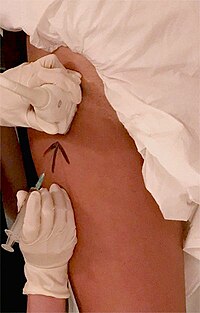
Photo from wikipedia
Background: Various methods exist for managing the joint capsule during the Latarjet procedure. Repairing the capsule to the native glenoid rim results in an extra-articular bone block, while repairing it… Click to show full abstract
Background: Various methods exist for managing the joint capsule during the Latarjet procedure. Repairing the capsule to the native glenoid rim results in an extra-articular bone block, while repairing it to the remnant coracoacromial ligament stump of the coracoid graft renders it intra-articular. The technique that optimizes patient outcomes is not well defined. Purpose: To compare the outcomes of intra-articular and extra-articular bone block techniques for the Latarjet procedure. Study Design: Systematic review; Level of evidence, 4. Methods: Using PRISMA (Preferred Reporting Items for Systematic Review and Meta-Analyses) guidelines, we queried the PubMed, EMBASE, and the Cochrane Library for all studies reporting outcomes of the Latarjet procedure with a clearly defined method of capsular repair that rendered the coracoid graft intra-articular or extra-articular. The included levels of evidence and degree of heterogeneity in this study precluded meta-analysis. Outcomes of interest included preoperative variables, surgical technique, rehabilitation protocols, functional outcome assessments, recurrent instability, range of motion, and radiographic findings. Results: A total of 16 studies including 816 patients were included. A total of 8 studies employed an intra-articular bone block in 338 patients, while the other 8 employed an extra-articular technique in 478 patients. There was variation among studies in reference to baseline patient characteristics, surgical techniques, rehabilitation, methods for assessing patient outcomes, and follow-up times. Rates of postoperative instability were reported in 8 intra-articular (0%, 0%, 2.1%, 2.7%, 3.2%, 5%, 5.4%, 5.9%) and 7 extra-articular (0%, 0%, 1.2%, 2%, 3.9%, 6.3%, 14%) bone block studies. Postoperative osteoarthritis or progression of preoperative osteoarthritis was reported in 5 intra-articular bone block studies (0%, 5.6%, 23.5%, 23.5%, 25%) and 4 extra-articular bone block studies (0%, 1.9%, 5.2%, 8.6%). Conclusion: Varying capsular repair methods appeared to provide similar outcomes regarding stability. There was an apparent trend toward higher rates of post-traumatic arthritis among studies in which an intra-articular bone block technique was employed; however, it is possible that this was influenced by substantially different follow-up times between groups and other various sources of heterogeneity among the included studies. There were no studies in the literature directly comparing intra-articular and extra-articular bone block techniques. Large-scale randomized controlled trials or comparative studies are needed to draw stronger conclusions comparing the 2 techniques.
Journal Title: Orthopaedic Journal of Sports Medicine
Year Published: 2022
Link to full text (if available)
Share on Social Media: Sign Up to like & get
recommendations!